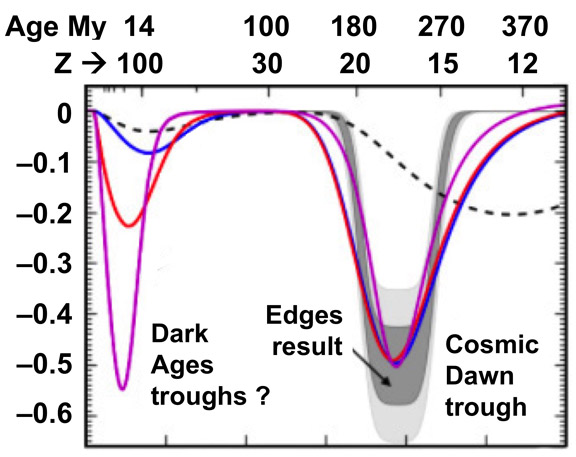|
Before
leaping over the Moon, I want to let my LA-area readers know I will be
teaching two courses at UCLA’s Osher Institute — one this Oct to Dec and
the other Jan through Feb 2020. See my website for details.
 Our
prior newsletter introduced the FARSIDE proposal, primarily by
Caltech/JPL scientists, for a radio telescope on the far side of the
Moon. We also examined what FARSIDE would contribute to our
understanding of exoplanets in the “habitable” zones of nearby stars. This newsletter continues exploring anticipated FARSIDE discoveries, ending with those that excite me most. Our
prior newsletter introduced the FARSIDE proposal, primarily by
Caltech/JPL scientists, for a radio telescope on the far side of the
Moon. We also examined what FARSIDE would contribute to our
understanding of exoplanets in the “habitable” zones of nearby stars. This newsletter continues exploring anticipated FARSIDE discoveries, ending with those that excite me most.
> FARSIDE
can detect and image our Sun’s radio bursts out to great distances,
establishing their location and spatial structure, which should help
reveal the underlying physics of the emission process.
>
FARSIDE will study radio emissions from lightning and aurora on the gas
giant planets Jupiter, Saturn, Uranus, and Neptune to better understand
their atmospheric dynamics.
>
FARSIDE will analyze the Moon’s interior by monitoring radio bursts
from external sources. The long wavelength radio waves that FARSIDE can
detect penetrate the Moon’s upper layers of regolith and bounce off any
higher density underlying material, including bedrock, a core (if any),
or isolated heavy objects (perhaps imbedded colliders). Such radio
bursts are commonly produced by Jupiter, but can also be generated by
the lunar-orbiting satellite.
>
FARSIDE will also search for any major yet-undiscovered bodies in our
Solar System beyond Neptune. FARSIDE can effectively search for any
large bodies with a magnetic field out to several hundred times Earth’s
orbital radius. An immediate target is the putative “Planet 9”.
The
existence of a distant Planet 9 is the brainstorm of Caltech
astrophysicists Konstantin Batygin and Michael Brown. Brown is the guy
responsible for demoting Pluto to “dwarf planet” status. Perhaps he is
trying to make amends, and bring our Solar System back up to nine
planets, as we were all taught as children.
Planet
9, if it exists, could explain an observed clustering of extremely
distant “trans-Neptunian” bodies that otherwise seems highly improbable.
To provide the right gravitational pull to explain this strange
clustering, the mass of Planet 9 would have to be 5 to 10 times Earth’s
mass, and its orbit would have to be 400 to 800 times larger than
Earth’s. Planet 9 would be several thousand times more massive than
Pluto. Brown says anything with those properties would gravitationally
dominate the outer Solar System, and would qualify as a full-fledged
planet.
> Lastly,
FARSIDE can lookback to nearly the beginning of time by employing
hydrogen’s 21-cm spectral line. Since hydrogen is by far the most
abundant element in the universe, 21-cm radiation fills the sky and has a
cosmic story to tell.
[Tech
note: radiation of wavelength 21 cm is emitted or absorbed when
hydrogen transitions between the parallel and anti-parallel spin states
of its proton and electron.]
From
nearby sources, the frequency of the 21-cm spectral line is 1420 MHz.
But cosmic expansion reduces the frequency we observe when that light is
emitted by very distant sources.
For example, consider a galaxy at redshift z=1.
That italicized phrase means the light we see now was emitted when the
universe was 1/2 = 1/(1+z) its current size, which occurred 8 billion
years ago. The wavelength of the 21-cm light emitted by that
distant galaxy has been stretched by the expansion of the universe.
Since the universe doubled in size, that light’s wavelength also doubled
to 42-cm, and its frequency became 710 MHz. At redshift z=2 — a lookback time of 10.5 billion years, when the universe was 1/3 its current size — that frequency becomes 473 MHz.
FARSIDE
can measure frequencies as low as 10 MHz. For the 21-cm line, this
corresponds to z=130, when the universe was only 12 million years old —
less than 0.09% of its current age of 13.8 billion years.
My
June 2018 newsletter titled “First Stars” explores the startling
results of the EDGES experiment: the presence of UV (ultraviolet)
radiation far earlier than our standard model of cosmology predicts.
This unexpected UV might be due to stars forming earlier, primordial
black holes, or perhaps an intriguing surprise.
In the chart below, the vertical axis is the temperature deficit
in Kelvin of the 21-cm line, and the horizontal axis is the age of our
universe in millions of years, with the corresponding redshift z. The
temperature deficit is defined as the reduction in the effective black
body temperature of the 21-cm radiation relative to the CMB (Cosmic
Microwave Background) radiation.

The
Dark Ages are when there were no bright lights in our universe. They
begin 379,000 years after the Big Bang (at z=1100), when protons and
electrons combined to form neutral hydrogen, quenching the initial
cosmic fireball. The Dark Ages end at Cosmic Dawn, when the first stars
began shining brightly. The end date is uncertain — EDGES favors
100 million years after the Big Bang (at z=30), while others favor 300
million years (z=14).
EDGES discovered the trough during Cosmic Dawn.
Above,
the dashed curve represents the prediction of the standard model of
cosmology. The blue, red and violet curves represent three prominent
alternative models — each is tuned to match EDGES, but each predicts a
different Dark Ages trough.
FARSIDE
would be the first instrument capable of detecting the Dark Ages
trough, and thereby establish which model best describes our universe.

Best Regards,
Robert
Aug, 2019
Note: Previous newsletters can be found on my website.
|